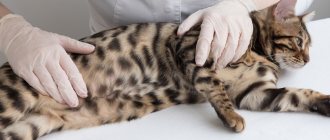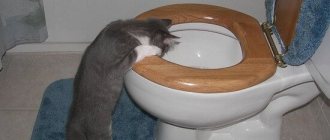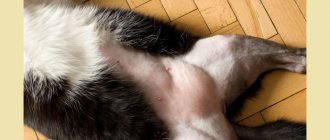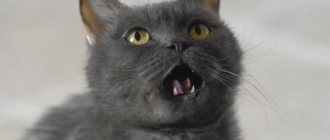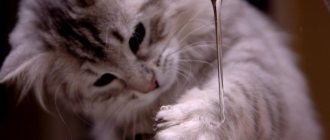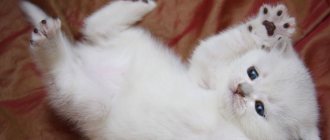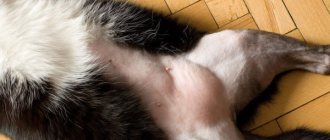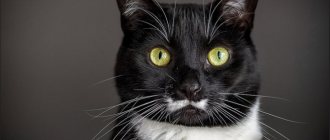Victoria Rashidovna Khazimulina
veterinarian Petstory
A large belly in a kitten can indicate pathologies such as helminthic infestation, intestinal diseases, peritonitis, etc. The size of the abdomen in the cubs of different animals may differ and depends on age, type of feeding, activity and even breed. Why a kitten has a bloated belly, and what to do about it, we will discuss in detail in this article.
The main causes of a big belly in kittens
Variant of the norm
A large belly in a kitten up to 3 months old can be considered normal. This is due to the fact that he still has little muscle mass. As cats get older, their stomachs tighten.
Signs that a kitten has a big belly is normal:
- the stomach becomes smaller after visiting the toilet;
- the kitten has a good appetite;
- he goes to the toilet regularly (at least twice a day);
- the abdomen is not painful or hard when pressed;
- no belching, gas, diarrhea, vomiting.
Constipation and intestinal obstruction
Decreased peristalsis (hypotension) is most often associated with diet. Lack of fiber and bones can cause hypotension and cause constipation. It all starts with the fact that the kitten goes to the toilet less than 2 times a day, its stool is dry, and its stomach becomes dense. The baby sits in the tray for a long time and strains; drops of blood may appear in the stool. Over time, this can lead to megacolon.
With complete intestinal obstruction, cats become restless, may refuse to eat, and vomit. If the appetite is preserved, vomiting will occur with undigested food.
Gastrointestinal diseases
Inflammation of the gastrointestinal tract (gastroenterocolitis, pancreatitis, IBD, etc.) occurs due to infections, helminths, and improper feeding. The abdomen becomes painful and hard. Additional symptoms: vomiting, diarrhea, lethargy, decreased appetite.
Flatulence
Flatulence in a kitten is not at all uncommon. At the same time, the abdomen enlarges, becomes dense, and there may be pain. With a gentle massage of the abdomen, the animal becomes relieved and may pass gas. They are formed due to the activity of certain microorganisms in the intestines. Most often the reason lies in diet.
Helminths
Even animals that live in an apartment and do not go outside can have helminths (worms). Cats are extremely clean creatures; they actively lick their fur, paws, and tail. You can bring the eggworm home on clothes or shoes, and the baby, by rubbing against you, will become infected with them. If there are too many parasites, the kitten will have a bloated stomach and problems with digestion, there may be vomiting or diarrhea, refusal to eat, and lethargy.
Ascites
Ascites (dropsy) is an accumulation of free fluid in the abdominal cavity. The most common cause is feline viral peritonitis (FIP).
Ascites also occurs against the background of heart disease, liver disease, protein loss, intestinal perforation, and pyometra (inflammation of the uterus).
With ascites, the kitten’s abdomen becomes voluminous and round, and the abdominal wall characteristically springs when pressed. As fluid accumulates, kittens have difficulty moving, the abdomen becomes painful, constipation and vomiting appear, and as a rule, the skin and mucous membranes become pale or jaundiced.
Liver diseases
The liver is the body's main detoxification organ. It occupies a fairly large volume of the abdominal cavity. With excessively active work or inflammation (infection, injury), it will increase, and the abdomen will noticeably grow.
In addition to an enlarged abdomen, the following symptoms may occur: vomiting, diarrhea, yellowness of the mucous membranes, lethargy, pain in the right hypochondrium.
Urinary retention
The cause of urinary retention in kittens may be an abnormal structure of the urinary tract.
(congenital anomaly), secondary hyperparathyroidism (occurs against the background of improper
feeding) or inflammatory diseases such as cystitis.
If the urethra is obstructed, the bladder will increase in volume and the abdomen will become large and dense. As a rule, the process is accompanied by unsuccessful attempts to urinate, vocalization, and pain in the lower abdomen. If help is not provided in time, symptoms of acute renal failure will begin (vomiting, shortness of breath, refusal to eat). This is a dangerous condition that requires immediate medical attention.
Hurry up, choose a box and find out what gift awaits you
Discount on pet insurance
Promo code copied to clipboard
Uterine diseases
In cats older than 5 months, the first signs of heat begin to appear, which means they become susceptible to diseases of the uterus and ovaries (cysts, endometritis, pyometra). With these pathologies, pathological processes may begin in the horns of the uterus, and fluid (pus, exudate) will begin to accumulate in it. Additionally, there may be signs of ongoing estrus, discharge from the loop, fever, thirst, lethargy, and vomiting. Sometimes the disease is almost asymptomatic, and the owners do not notice anything other than a voluminous abdomen.
Polycystic disease/neoplasms
Kittens can also have tumors and cysts in their internal organs. Most often they are localized on the kidneys and liver. The disease can occur in absolutely any cat, but there are breeds at risk (Persian, exotic). In the early stages there will be no symptoms, but as it progresses, food refusal, thirst, lethargy, vomiting, foul odor and jaundice may appear.
In what cases should you contact a veterinarian?
The most dangerous causes of an enlarged abdomen in a kitten are peritonitis and ascites. Without timely veterinary care, the pet may even die. How to recognize these dangerous pathologies:
- Peritonitis is an inflammation of the abdominal cavity of an animal. It is necessarily accompanied by the following symptoms: elevated body temperature; vomiting; refusal of food; weakness; apathy.
- Ascites is the formation of excess fluid in the abdominal cavity without the presence of an inflammatory process. It is worth noting that the kitten itself can be thin, and the circumference of the abdomen stands out sharply against the general background. If the owner lifts the kitten, holding it under his front paws, the baby’s belly will “fall”, forming a pear shape.
Peritonitis and ascites are life-threatening conditions, so you need to take the kitten to the vet as soon as possible. Only a specialist can treat these pathologies, and sometimes even minutes count.
Diagnostics
Visit doctor
To understand why a kitten has a large and hard belly, you need to undergo an examination at the clinic.
and take a thorough medical history.
The doctor will assess whether there is pain, fever, paleness, or yellowing of the skin. The doctor will need to provide all the information about the pet - about treatment for parasites, vaccination, nutrition, maintenance, etc.
Ultrasound diagnostics
An ultrasound will be required to diagnose any of the listed diseases.
Laboratory research
- A clinical blood test will be required if there is a suspicion of infectious and inflammatory diseases: peritonitis/ascites, inflammation of the uterus.
- Blood biochemistry is needed to diagnose kidney and liver diseases, as well as ascites.
- A PCR test for antibodies to feline coronavirus infection (FIP) should be taken if there are signs of peritonitis and ascites.
- Exudate fluid from ascites should be examined for infectious peritonitis and undergo cytology.
When to see a doctor
Contact your veterinarian immediately if your animal has a large intestine combined with excessive drooling, retching, or vomiting. In addition, a visit to a veterinarian is mandatory in order to exclude the following life-threatening pathological conditions:
- liver diseases;
- massive infection with worms;
- diseases (including malignant) of the pancreas;
- abnormalities in the functioning of the immune system;
- obesity.
Treatment
Constipation, intestinal obstruction
If peristalsis decreases, treatment involves adjusting the diet. For constipation, antispasmodics and laxatives (for example, lactulose) are prescribed.
In case of partial obstruction, symptomatic therapy is carried out (droppers, antiemetics, painkillers). If the obstruction does not resolve, the problem is solved surgically.
Gastrointestinal diseases
As a rule, the diet is prescribed first. Depending on the location of the inflammation and its cause, the following may be prescribed: antibiotics, painkillers, antiemetics, gastroprotectors, prebiotics, droppers, anthelmintic drugs.
Helminths
Kittens, regardless of the size of their bellies, need to be treated for parasites every 1.5-2 months. If there are symptoms of helminthic infestation (worms in stool, vomit), then treatment should be carried out in therapeutic dosages, which will be individually calculated by the doctor at the appointment.
Flatulence
A kitten may have gas due to improper feeding. Treatment consists of dietary adjustments, abdominal massage and the use of carminatives.
Ascites
Treatment for ascites depends on its cause, but it is always an alarming symptom.
For viral peritonitis, the prognosis is cautious. In recent years, there is information about treatment with an antiviral drug from humane medicine (GS), which shows high effectiveness. But there are still few studies, and the drug is difficult to use due to its high price and dosage regimen. Antivirals from a regular pharmacy in the form of tablets (acyclovir, etc.) not only will not help in treatment, but can be dangerous for cats.
If the cause of ascites is diseases of the internal organs, droppers, intravenous albumin, tonics, hepatoprotectors, and antibiotics may be required.
If there is a large accumulation of fluid, it is aspirated (pumped out).
Liver diseases
For liver diseases, hepatoprotectors and symptomatic treatment (antiemetics, antispasmodics) are first prescribed. After diagnosis, antimicrobial, choleretic drugs, diet, and drip infusions may be recommended. Sometimes surgery is required.
Urinary retention
Treatment of acute urinary retention can only be provided in a clinic. To drain urine, a urethral catheter is installed or cystocentesis is performed (a puncture through the abdominal wall).
Depending on the cause of urinary retention, the following are prescribed: pain relief, diet, antibiotics, drip infusions, drinking regimen, supplements. If large uroliths form or there is an abnormality in the structure of the urinary system, surgery will be required.
Uterine diseases
Conservative treatment of uterine diseases in cats has been developed, but only shows its effectiveness with early diagnosis. In addition, the risk of relapse in the next heat remains. Therefore, sterilization (OGE) is done much more often. In this operation, the uterus and ovaries are removed.
Polycystic disease and neoplasms
Neoplasms of almost any nature are recommended to be removed and sent to the laboratory. Based on the histology results, chemotherapy may be prescribed. Cysts, as a rule, appear again even after removal. Their effective treatment has not been developed. Symptomatic therapy is used, and regular examinations and ultrasounds are performed to monitor the size of the cysts.
What to do to eliminate the pathology?
If the cause of bloating is constipation, then the drug Duphalac will help to cope with the problem.
If the kitten's sides are swollen due to a severe internal illness, the doctor will hospitalize the pet and, if necessary, perform surgery. In other cases, you can deal with the problem at home. For constipation, you can give your pet the drug Duphalac and use microenemas. Vaseline oil will help improve digestion; its dosage is 0.1 ml per 100 g of weight. It is recommended to give the product 2-3 times a day.
If the cat's swollen sides are a sign of helminthic infestation, in this situation antihelminthics will help normalize the condition. Doctors at the Zoovet clinic point out that not every drug is intended for kittens aged 2-3 months. Therefore, the veterinarian must select the medicine, taking into account the baby’s age, the degree of invasion and other individual characteristics.
After giving birth, the cat's abdomen will return to its normal position without special treatment. The problem of overeating is easy to eliminate. Often, increased appetite is associated with a lack of vitamins and other elements in the body. Therefore, it is better to feed your cat with ready-made food, where all the ingredients are balanced and selected for a certain age.
Prevention
Balanced diet
To prevent flatulence, constipation and dynamic intestinal obstruction, first of all, it is important to feed the kitten correctly. The correct ratio of proteins, fats and carbohydrates is only a small requirement for a balanced diet. No less important is the content of fiber, vitamins, and microelements. If you are feeding your baby food, then simply select the diet according to age and breed. However, if you feed your pet a natural diet, it is important to balance all the nutrients, and a nutritionist will help you with this.
Regular treatments for parasites
As we discussed earlier, deworming in kittens should be done once every 1.5-2 months. But there is not a single drug that acts on absolutely all parasites, so it is recommended to change the drug every 1-2 treatments in order to cover a wider range of pathogens.
Sterilization
If you are not planning kittens, then it is best to carry out routine sterilization. Cats undergo such operations from 4 months. This will protect against the appearance of cysts on the uterus and ovaries, and early castration (from 4 to 8 months) prevents the formation of mammary gland tumors.
Limiting contact with sick animals
Ascites often occurs due to the peritonitis virus. The only way to prevent infection is to prevent your pet from coming into contact with sick and potentially dangerous animals. Don't let him outside unattended. Quarantine for at least 2 weeks when getting new animals.
What is the problem: main reasons
Veterinarians claim that the main source of hernial protrusion in kittens are anomalies that occur during intrauterine development, which is why the disease is largely congenital in nature. Acquired pathology is possible only in adult cats.
When the owners notice a protruding navel in a kitten, this may indicate a hernial protrusion. The following factors can influence the pathological process:
- Genetic predisposition. A bulging belly in a cat in the first months of life is a consequence of the characteristics of genes, the development of which is disrupted even in the womb. With such a violation, the umbilical ring is formed incorrectly, which is why the ligaments and veins may subsequently fall out.
- Improper handling of the umbilical cord when giving birth to a cat. Often, owners decide to interfere with the birth process in animals, which can lead to unpleasant consequences. If the umbilical cord is cut incorrectly, then there is a high probability of an increase in the diameter of the umbilical ring, as a result of which a hernia soon occurs.
- Increased pressure inside the peritoneum. It is a common cause of problems in kittens, as well as adult pets. Such a violation is possible with regular constipation, prolonged vomiting or increased stress.
- Various injuries and mechanical damage. Symptoms of an umbilical hernia in small animals can appear after a fall from a height, a strong blow or a bruise, as a result of which the abdominal muscles are stretched and the internal organs are displaced.
Bloated belly in kittens: main thing
- The reasons for the appearance of a large belly in a kitten can be: helminths, improper feeding, infections. And sometimes a big belly is normal for a small kitten.
- Diagnosis requires a doctor's examination and ultrasound. Blood tests or effusion tests may be required (for peritonitis, infections).
- For treatment, depending on the cause, diet therapy, antibiotics, carminatives, anthelmintics, laxatives and other drugs are used.
- Prevention consists of a balanced diet, limiting contact with infected animals and regular treatments for parasites.
Disease prevention
To avoid abdominal enlargement and cramps, you should use the following rules:
- Buy quality kitten food made from natural ingredients. It is unacceptable to feed small pets canned food, as well as food that is consumed by humans. It is better to give a newborn cat special mixtures for a certain age, which can be found in pet stores.
- Don’t forget to drink water; every meal should be washed down with a sufficient amount of liquid. Therefore, it is recommended to provide the animal with constant access to clean water.
- Do fasting days with minimal consumption of carbohydrates and fiber.
- Gradually switch from baby food to adult food, first consult with a veterinarian.
- Be examined every six months to exclude the presence of serious pathologies.
- Monitor the quality of the animal's fur.
- Provide your pet kitten with timely water treatments.
- Monitor your pet's sleeping area, clean and ventilate it in a timely manner.
Important! To prevent your kitten from developing a big belly again, it is recommended to carry out deworming regularly.
Bloating in a kitten is an unpleasant symptom that appears as a result of infectious and nutritional disorders. If a problem is detected, you must immediately contact a veterinarian and undergo an examination. Based on the results of diagnostic procedures, further treatment tactics will be determined and all necessary recommendations will be prescribed.
Diagnostic procedures
In addition to palpation, pathology in an animal can be detected using ultrasound.
Only a veterinarian can distinguish an umbilical hernia in a kitten from other pathological disorders. If unpleasant symptoms appear, you should contact a veterinary clinic. Often, to make a final diagnosis, it is enough for a specialist to conduct a visual examination of the pet and palpate the abdomen. To assess the condition of internal organs and the severity of the disorder, additional laboratory and instrumental diagnostic methods can be performed. The basis for diagnosing an umbilical hernia in a kitten is ultrasound examination.
